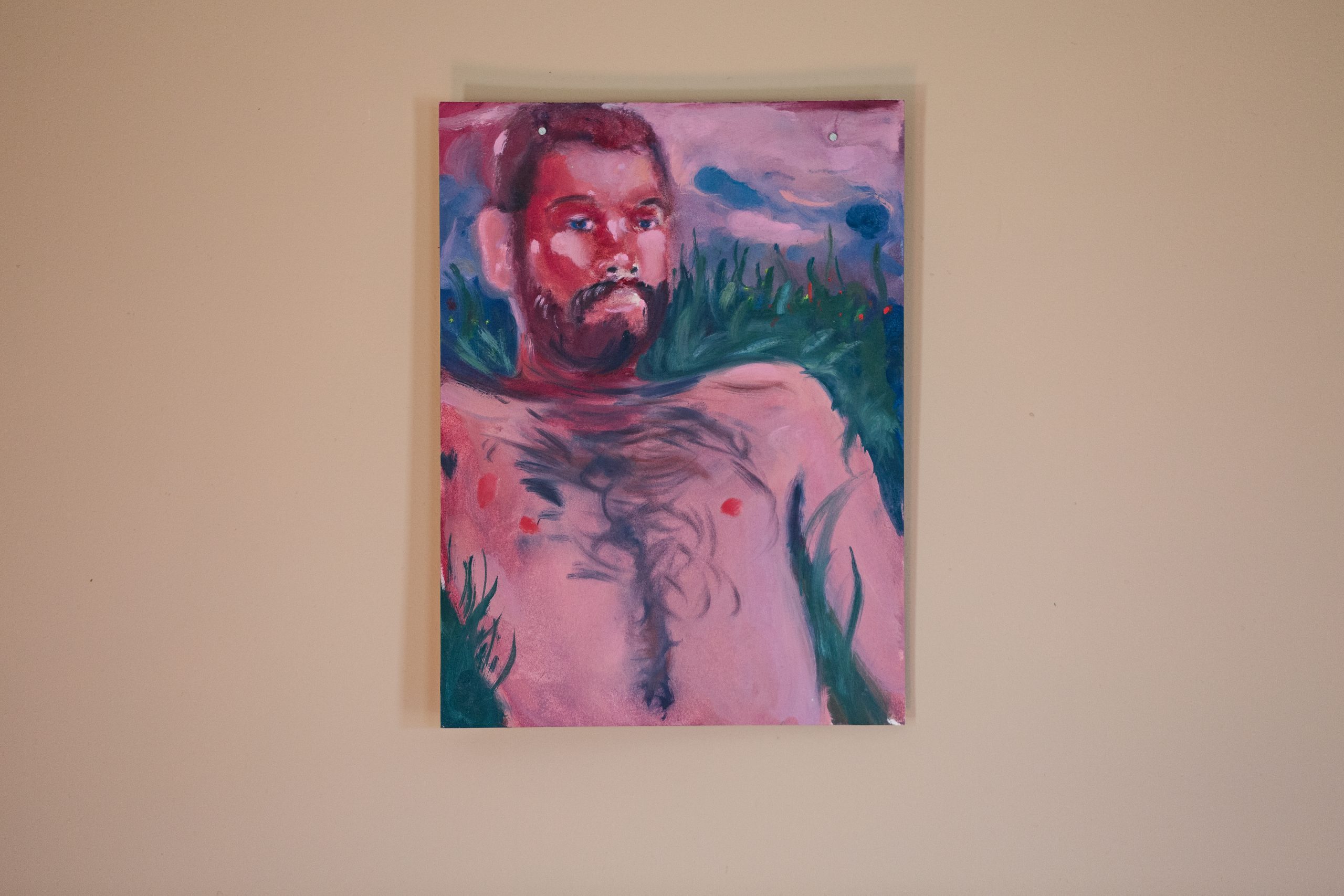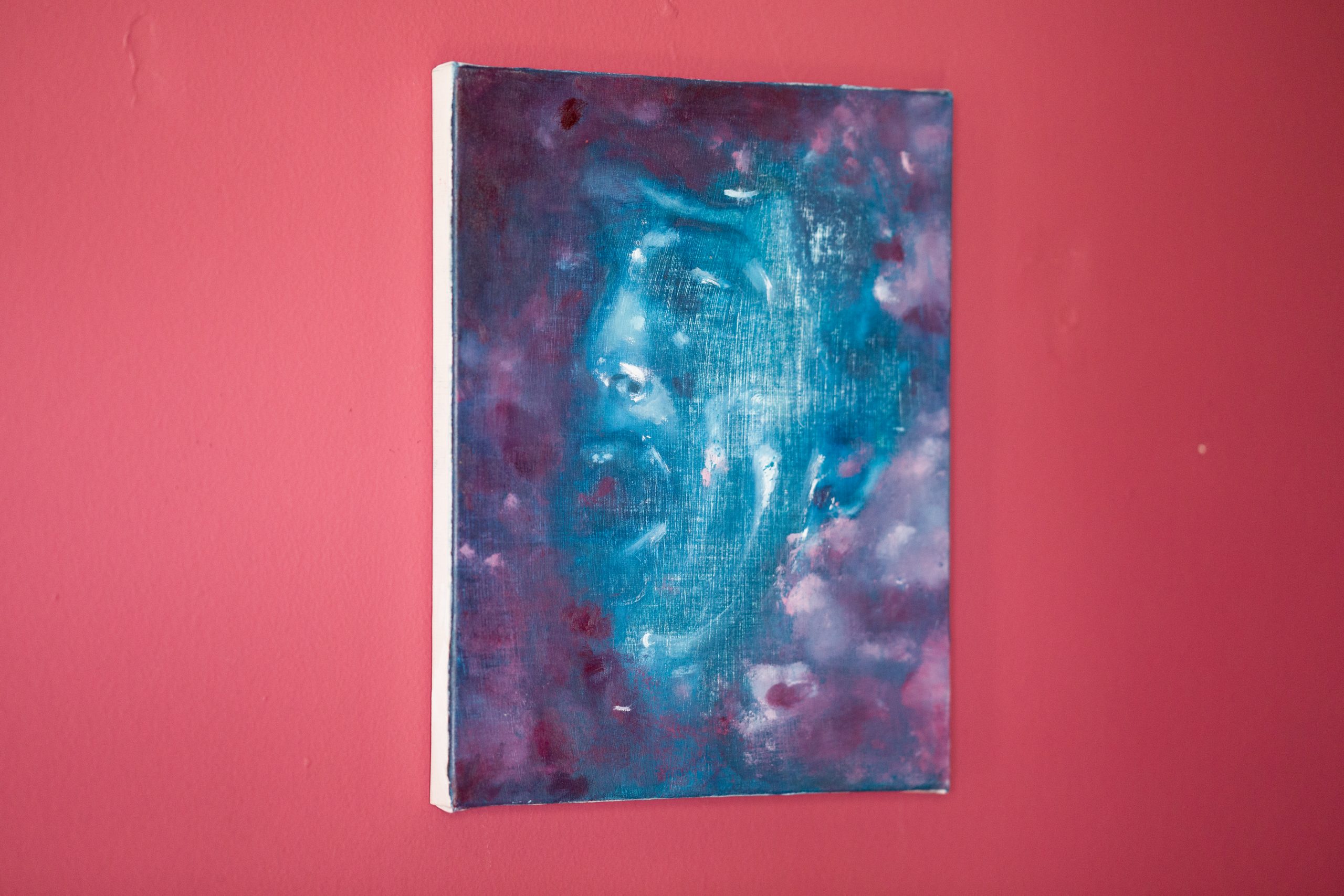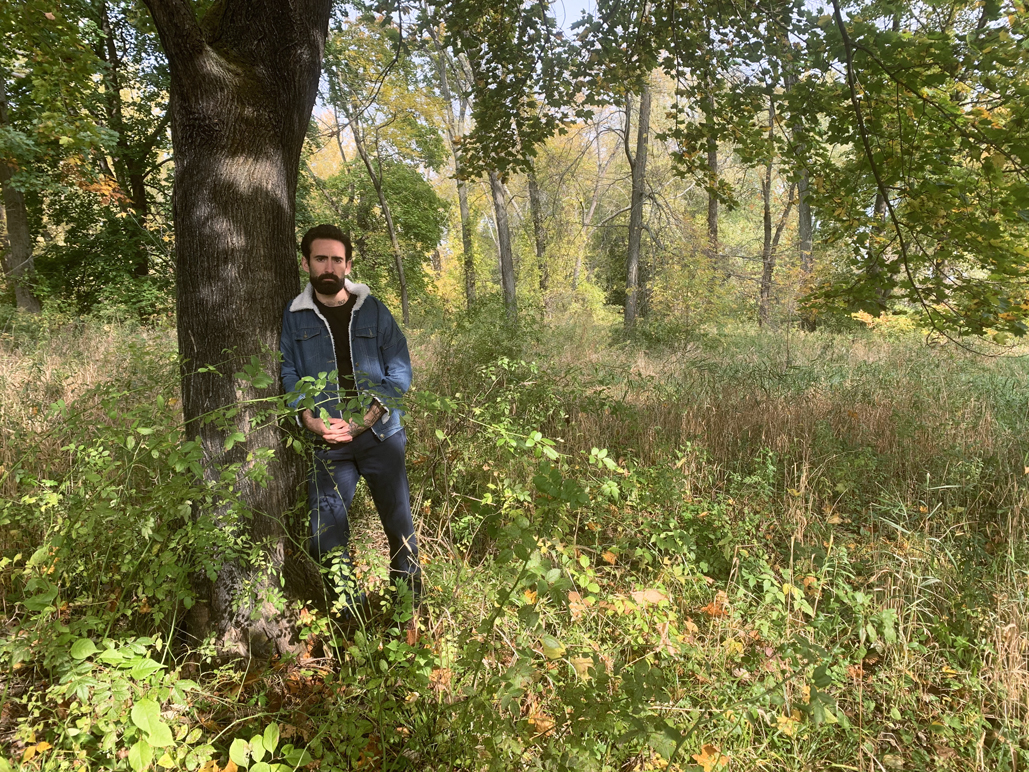
All images courtesy of the artist and MARCH. Photography by Alan Rideout.
AARON SKOLNICK
In conversation with Stuart Horodner, the Director of the University of Kentucky Art Museum, the painter discusses cruising in rural areas and his current exhibition, Between Two Suns, an installation organized by MARCH in an abandoned farmhouse in Kentucky.
Hi Aaron. How’s Hudson this morning? How long have you lived there now? It’s a nice cool morning with great light in the studio.
How important are the conditions in the studio for you? In what way?
The amount of space to work, the connection to a domestic setting. The spaces I think of you working in are all relatively intimate. It’s very important. I like a rather small studio as my work is not that big in scale. The studio being in my living space is important to me as of now as I like to be able to walk in whenever I want.
Seems like some of what you are making work about is people (men) in a state of naturalness, as if caught between the bedroom, bath, kitchen, etc. I have been focusing on cruising the past 6 months, men resting, waiting, watching action happen around them. The fact that they are set in a rural moment allows them to rest more in my eyes. There is a real art to being patient.
What was the impulse to take on “cruising?” And this brings up the fact that you’ve always worked on one specific series at a time. How are these new images coming about…through drawing, photos? Cruising came about when I was thinking about my faggot tattoo, and why I have it — being called faggot and being made fun of before I came out for being very “theatrical.” Hiding in plain sight led me to thinking about how we hide our desires, how we look without being caught and how we occupy space, how desires dictate that risk factor for occupying space and being forced to travel for those desires. I started working in series when I started living with Louis (Zoellar Bickett). Living with him was my grad school education in a way. Working on these in depth projects really taught me how to see all the way around a subject. “If you make it once, make it ten times and then a hundred,” Louis would say.
You definitely work through ideas by making…different attitudes, color schemes, degrees of realism. I’m thinking of the vigilance with which you documented Louis through his illness and eventual death, but also the numerous drawings of men, couples, blowjobs, reclining torsos — and many self-portraits. Yes, I love pushing myself, and when I feel comfortable, I have to throw a wrench in.
I want to return to patience. What can you say about that — in your rural environment but also in general. How does patience play with your own ambition? Well, as you know I am extremely energetic and living in a rural(ish) area helps me a lot. In cruising one has to be very patient and is the main part of the act, you may not have a sexual encounter, and that is part of the game. I wanted to depict men in a mode of relaxation, okay with waiting, being happy to be in a place of momentary safety and nirvana. As for patience in my life and my studio practice, that really started happening this past year, looking back at the drawings of Louis dying and realizing that at a young age I had already done the end of life moment with a partner. Louis really was my greatest teacher, he always taught me to put my head down and just keep working. I am ambitious and know what I want for my life, allowing myself to slow in a way in the studio has helped me tremendously, allowing the work to grow in ways it hasn’t before. As Philip Guston says, “ push everyone out of the studio.” Your voice will come, and it will grow and change, you just have to be willing to accept it. Also paintings need lots of patience, the little battles. I have been fighting with a painting for three days, it keeps showing me itself and I fight it off, and it keeps coming back to this certain place naturally, and then I try to make it something it’s not. That’s an everyday battle, but it’s fun.
Talk a bit about the wrenches you throw or the conscious changes you make when things get comfortable. The images you’re making have a kind of immersive dreamy quality, the saturated color of the body and the background. I remember that you watched that Guston documentary. He’s so smart about the process and what one makes and what one knows. How the images emerge and make demands. Let’s talk about your process. If things get in that comfortable moment, I often sand something down or add a different mark-making tool into the process, like plastic sheeting that I will paint on and then press onto the canvas, often painting the lights and or middle grounds with and it makes it a lot of fun. Sanding into the work came about that way, I was working on a painting for my show this winter and it just felt too easy so I made myself sand into it to work around something. I will sometimes cover a painting in a single color and make myself dig it back out. Paintings do make demands, they do live and it is a conversation. Things, marks, moments happen when you get in that state that you could never dictate.




How do you know when a painting is finished? Is there a quality you’re hoping to achieve that emerges? Many have a “one session” directness and its hard to see the many adjustments that might have been part of the process. I’d say immediacy is a definite quality in your work. Immediacy and directness are definitely qualities that are and have been a part of my practice. Though my works are rather small, they can take a couple of days to finish, depending, but that feeling is really unexplainable. It sort of feels like you walk in the room and a presence is gone; you look at the work and realize that if you were to put another stroke on it you would be repainting it.
How about the recent night skies, moths, and other images in a landscape tradition? Where are those coming from? Thinking about those moments of occupying space again, often I felt most safe and comfortable as a child when I was alone in a field by our house, especially when I knew I was gay, and there would be men around the house that were friends of my stepdad or my brothers friends. I was so afraid of being found out, so I would go off by myself, and those are things I would notice. They always seemed magical to me and fit in with this work a lot. For me now those images sort of represent the infinite.
These experiences formed you? So interesting. I know you as a very out and outrageously confident person. It took a lot to get there. When I came out, I really just said no more hiding in any way.
These words — alone, hidden, safe, secret — all good ones describing the artist in the studio. If you don’t like me, you don’t like me. I am very aware that I am not everyone’s cup of tea.
I know you as a very aware artist…of past painters and contemporary ones. Can you talk about people you feel a kinship with? Artists you know and speak with, ones you follow, and what you get out of that dialogue or sense of peership. Oh yes! I love art — I just adore Kati Heck, Dana Schutz, Marlene Dumas, Philip Guston, Pierre Bonnard, Wolfgang Tillmans, Paul P, Bacon, Lisa Brice, Lisa Yuskavage, Alvin Baltrop, Ben Sledens, Jonathan Lyndon Chase, and Cecily Brown. Doron Langberg is always blowing my mind along with Ryan Travis Christian, Anthony Cudahy, and Jenny Morgan. I think about all these artists daily, moments in particular works that really pushed me. Oh, and Elijah Burgher and Louise Bourgeois.
That’s a big group. What do you feel you share with some of them, or where do you differ? It is! An interest in being human, they all really focus in humanness; their work in some way humbles me. They all motivate me too. What we share? The figure, what it means to be, making ourselves and the audience a little uncomfortable in some ways if we do it right. Every time I leave a show with Cecily in it, I get a little uncomfortable, and I hope I can do that in some way. Ever since I did the black panther, civil rights drawings, I saw the power of being left vulnerable by art.
Ah, good return to something I wanted to ask you about. There is a series from a few years ago, and the UK Art Museum purchased some of these works. I’m including I Am a Man (2015) in the upcoming This is America exhibition. Can you talk about the desire to make works using civil rights imagery? When I finished the Jackie O series, I knew I wanted to focus on something else around that time period. I realized how much technology had changed the way we were allowed to see what was happening. I was doing research and found images that looked like history paintings, and I knew I had to draw them. To deconstruct these narratives, I became amazed at how much information was left out of my education. I was drawn into the subject and I thought there was great responsibility to use these images, as they were aggressive images of black bodies—and I was a 25 year old gay white male in the south.
Do you think you’d feel comfortable making those images now? So many questions about who can and should speak about race, and how, and when. Oh yes, it’s about intention and how you know you are not a voice for people. You are working through an uncomfortableness for yourself.






We are living in a time of extremes and nuanced discourse seems very difficult. When I showed the 45 burning crosses in NYC and had to talk about them to so many people it became very clear it was about intention. Once you realize the power your work has as a tool of communication and education, when it’s out in the wild, intention is so much of it. A lot of those conversations were defusing the situation of people that just wanted to argue with me.
I can imagine. I obviously am on the side of dialogue and developed debate. I love that art can be the jumping off point for a good argument. Do you think of an “audience” when you’re working? I used to, but not anymore. I feel like the work grew when I got the audience, outside the studio. I am very aware that this is what I love, so I just start in the studio thinking about my subject and the different ways to go about it.
Makes sense. How about venues? You have a project coming up with Institute 193, where a selection of recent works will be shown in a decayed domestic space in Kentucky. It might attract a particularly adventurous audience and the site might add a specific narrativity to the images. What are your hopes for that installation? I just had a string of group shows come down and one or two going up. I am very excited about the install with Phillip March Jones as I love doing site-specific installs and it allows me to see the work in a different way. Sometimes it’s nice to say fuck the white walls.
I agree. I loved including you and Louis in the Peoples Portal — a two day pop-up exhibition in a mid-century bank slated for demolition in 2015. Aqua blue peeling paint, large expanses of concrete and glass, terrific. That was the first project we did together. It was!! I loved how people almost walked by my piece as it was so small and the walls were naturally so busy.
That building is now a parking lot — sad. Do you think that loss is a major subject for you? And how do you think the Covid situation is affecting your image-making and overall focus these days? Oh god yes, even with this new body of work. My stepdad was abusive when I was growing up, so anticipation of violence in some way or loss is always in my work. I think that Covid just made me sit down longer and really look at what I was doing more. It has allowed me to experiment more. You can always wipe it away.
You have some new adventures coming up. I am moving! I’m very excited about it.
Is Bill, as subject/model something you want to discuss? I mean we could, I think it’s natural to show a deep love of your partner by depicting them.
So, you are moving to Houston, a great art city, to be closer to your partner. Bill has shown up as a consistent model in drawings and paintings during the past year or so. What can you say about the desire to and actual process of picturing someone you love over time? It’s a really interesting way to show the different levels of comfortability you have with them and how that can change back and forth. In paintings or depicting someone now, there is an air of performance more than there ever has been due to everything being so documented. So there is a part of it for me that slows time down for the two of us and makes it very romantic again.
One last question, what goes through your mind when you are running for several miles as you’ve been doing lately? I think about the paintings, what’s working overall or what’s not. It’s such a part of my practice now.
 Aaron Skolnick photographed at cruising area outside of Hudson, New York.
Aaron Skolnick photographed at cruising area outside of Hudson, New York.
Click here to view the online exhibition. “Between Two Suns” runs through December 1, 2020.